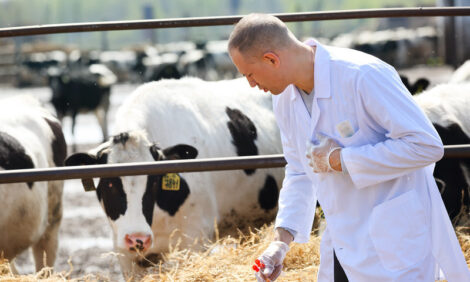



Predicting Water Intake by Yearling Feedlot Steers
Bodyweight and numerous weather factors affect water consumption by yearling feedlot steers but the effect of feed intake is minimal, according to new research from Colorado State University.In a recent issue of Journal of Animal Science, J.L. Sexson of Colorado State University and co-authors there and at the University of Wisconsin report that data from four separate beef cattle feedlot experiments were utilized in a retrospective longitudinal study investigating possible relationships between daily water consumption, dry matter intake and weather variables.
The experiments had been conducted at the Southeast Colorado Research Center (SECRC) in Lamar, Colorado, in 2001, 2003, 2004 and 2007. The data set consisted of 8,209 records from 2001, 2003, 2004 and 2007, with pen-based daily water consumption (L·animal-1) and dry matter intake measurements and calculated daily steer bodyweight from April to October in each year.
Daily weather data were obtained from the weather station located at Lamar Municipal Airport located approximately 1.9km from SECRC. Data collected consisted of daily high, low, and mean temperature; high, low, and mean humidity; high, low, and mean sea level pressure; mean wind speed; total precipitation; and average daily wind direction (cosine of radians from due north).
Univariate analysis demonstrated that the continuous variables of bodyweight, humidity and sea level pressure were negatively related (P<0.0001), whereas dry matter intake, temperature the previous day, daily temperature, change in temperature from the previous day, average wind speed, and the temperature-humidity index (THI) were positively related (P<0.001) to daily water consumption.
There was a trend (P<0.06) for the cosine of wind direction (1 = due north and -1 = due south) to be negatively related to water consumption.
The multivariate, parsimonious model predicting average daily water consumption included (P<0.05) average humidity, average humidity squared, high temperature squared, high humidity squared, low temperature, low temperature squared, low humidity, average sea level pressure, average wind speed, average daily bodyweight, high sea level pressure, low sea level pressure, high humidity and low humidity.
The generalised R2 of the parsimonious multivariate model was 0.32.
These results indicate that bodyweight and numerous weather factors are related to water consumption by yearling feedlot steers, concluded Sexson and co-authors. However, dry matter intake had minimal impact on water consumption for yearling feedlot steers consuming steam-flaked corn-based high concentrate diets from mid-spring to early fall.
Reference
Sexson J.L., J.J. Wagner, T.E. Engle and J. Eickhoff. 2012. Predicting water intake by yearling feedlot steers. J. Anim Sci., 90(6):1920-1928.doi: 10.2527/jas.2011-4307
Further ReadingYou can view the full report by clicking here. |
September 2012


